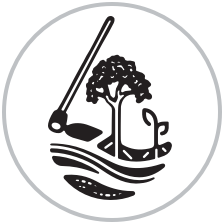General
-
How does RD differ from conventional agriculture?
Resilience Design (RD) differs from conventional agriculture by emphasizing a nature-based, regenerative approach that works with local organic resources rather than relying on external inputs like chemical fertilizers and pesticides. It focuses on enhancing soil fertility and structure; water management through techniques that slow, spread, and sink water into the soil, preventing erosion and improving moisture retention; and creating a biodiverse production system. All RD interventions are guided by a design process that is informed by a site’s unique constraints, opportunities, and ecological influences.
Unlike the static, top-down methods of conventional farming, RD engages farmers in a participatory, ecologically-driven, and adaptive process that evolves through observation and feedback. It integrates agroecology, permaculture, and other practices into a holistic system aimed at ecosystem restoration, food security, year-round income, and community resilience. While conventional agriculture often prioritizes short-term yields, RD is oriented toward long-term sustainability and resilience to environmental and economic challenges.
-
How are household permagardens different from other kitchen garden approaches?
Household-level permagardens follow a design process that engages foundational agroecological principles—building soil health, improving biodiversity, and managing rain and wastewater effectively—to ensure household production systems work with and improve upon the environmental conditions present at the site. An emphasis on agroecological principles allows permagardens to be successful even in the absence of high quality land, large amounts of water, or external inputs. The Approach emphasizes essential soil and water management techniques that diversify and boost production right at the home, making it an ideal complement to food security program interventions. Because the garden is designed and built by the household itself, it relies on local inputs that are within reach of household members and produces food and other crops they can use to bolster their food supply and livelihoods. With a site context-specific design, proper planning, and interactive management, high yields of annual and perennial nutrient-dense fruits, vegetables, fodder, and other useful crops can be available year-round.
For implementation support and materials, check out the Permagarden Technical Manual.
-
Is RD the same as Nature-based Solutions (NbS) approaches?
Resilience Design (RD) and Nature-based Solutions (NbS) share core principles—both use natural systems to tackle climate, food, and water challenges. RD is an ecologically-driven, practical, farmer-led approach focused on agricultural production, using local resources, water harvesting, soil regeneration, and biodiversity to build climate resilience. NbS is broader, often policy-driven, and applied in diverse sectors like urban planning, forestry, land restoration, and coastal protection. While RD can be seen as a specific application of NbS in agricultural production systems, its hands-on, community-centered design process sets it apart as uniquely suited for empowering smallholder farmers and restoring landscapes at the grassroots level.
-
Does RD apply at various implementation scales (from household-level to watershed-level)?
Yes, Resilience Design works across multiple scales—from household-level permagardens to full watershed systems. The core components of the approach–whole systems design, stabilizing hydrology, building healthy soils, and increasing biodiversity–are applicable at all levels. It is intentionally flexible and scalable to support resilience at multiple levels of an agroecosystem.
Explore further:
-
Is RD scaleable within my program?
Yes, with thoughtful facilitation to maintain quality and participatory roots as it expands. Scalability is approached and supported in RD programs in these ways:
Scalability Through Cascading & Mentorship
RD programs often use a cascade model, where each level of training uses mentoring and demonstration to share the process with a community. At the community level, lead farmers or community mobilizers are trained and then share knowledge with their peers in practical ways that build demonstration sites. However, unlike conventional Training-of-Trainers (ToT) models, RD emphasizes hands-on mentoring and co-design and site implementation over rote instruction disjoined from the land; building critical thinking and design skills, not just technique replication; and maintaining adaptive learning and community engagement at each level.
Context-Specific Replication
RD isn't a one-size-fits-all package. Instead, it promotes localized adaptation-based factors such as the levels of degradation, water, soil, slope, sun path, other ecological influences and social context. It is premised on a site context-specific design approach that uses a flexible toolkit of strategies that can be selected based on needs and unique site challenges and opportunities.
Real-World Applications
RD has been successfully scaled in hundreds of humanitarian contexts (e.g., refugee and IDP settlements using local organic resources) and development programs (e.g., farm-level sites, hill restoration projects, and DRR projects) within 50 organizations in over 26 countries globally. Core RD principles and practices are as applicable in arid, drylands contexts as they are in high rainfall sub-tropic or tropic conditions.
-
Can RD be integrated into our existing programs?
Yes, RD can be effectively integrated into existing agriculture, WASH, nutrition, DRR, NRM, and/or livelihoods programs. It is designed as a layered and cross-sectoral approach that enhances what you're already doing, rather than replaces it. For example, you can integrate RD into existing garden plots, farms, land restoration projects, or community areas by engaging community members, assessing and improving productive area designs, adding appropriate water harvesting structures, building living soils, and increasing the diversity of planting materials.
For a practical guide, use the Integrating the Permagarden Approach Tip Sheet which outlines how to add RD and permagardens to any program phase—from proposal to implementation.
-
Can you apply RD to Disaster Risk Reduction, WASH and other sectors besides agriculture?
Absolutely—RD is not just for agriculture. It's a versatile, cross-sectoral approach that integrates seamlessly into Disaster Risk Reduction (DRR), Water, Sanitation and Hygiene (WASH), nutrition, livelihoods, and even education and peacebuilding efforts.
For example, RD enhances DRR by reducing soil erosion and runoff through water-harvesting structures; creating “sponge villages” that absorb and store water to buffer floods and droughts; and building community capacity to observe, analyze, and adapt to changing conditions—core to long-term resilience planning. It supports WASH through promoting safe greywater reuse for productive gardens; water recharge systems like swales, infiltration pits, and mini-dams that improve groundwater levels and reduce standing water; and integrated hygiene and sanitation training through permagardens—e.g., compost toilets, bio-latrines, and waste reuse. RD intricately supports nutrition and food security by ensuring year-round access to diverse, nutrient-dense foods via permagardens and food forests and supports behavior change through hands-on, household-level learning.
-
Is RD a cost effective approach to agriculture, NRM and DRR humanitarian programming?
Yes, RD is highly cost-effective for a variety of different humanitarian programs – including those focused on agriculture, NRM, and DRR. Its emphasis on local inputs, participatory design, and long-term resilience provides excellent return on both financial and ecological investment. It reduces dependency on imported fertilizers and inputs by using locally available resources like compost, ash, crop residues, and greywater. It promotes low-tech, high-impact infrastructure, such as hand-dug swales, berms, compost pits, and contour beds to improve water retention and soil fertility, saving on irrigation and input costs. It also enhances natural buffers against climate shocks like droughts and floods by protecting topsoil and restoring landscapes, reducing the need for expensive recovery efforts later. Once designed and built, RD systems can remain productive with minimal upkeep. It also simultaneously improves nutrition, livelihoods, soil health, biodiversity, and water availability, making it a smart and cost effective investment for multi-sectoral humanitarian programming.
-
How does RD use local resources?
RD is built on the principle of maximizing the use of local resources—a critical factor for sustainability, cost-effectiveness, and empowerment. It improves soil health using compost, manure, ash, and nutrient-rich local plants like Tithonia diversifolia or Desmodium. RD captures rainwater through swales and pits aligned with natural contours, and puts household greywater to use. Structures like compost bins and fences are built from local wood and stone, and tools like A-frames are made from sticks and string. RD promotes the cultivation of local, climate-resilient crops and perennials, boosting year-round food availability. It prioritizes community knowledge and informal seed systems—building resilience through resources people already trust and understand.
-
How does RD work with local seed certification, seed saving and seed security?
RD champions seed sovereignty by promoting local seed saving, adaptation, and security. It favors indigenous seed varieties that can be saved season to season, strengthening climate adaptation and preserving culturally-important crops. RD transforms agricultural projects at different scales into living seed banks, protecting heirloom species like millet and leafy greens. It builds on informal seed networks—neighbors, families, and local markets—empowering farmers as biodiversity stewards. In emergencies, RD supports seed recovery with basic organic inputs and encourages long-term resilience through Seed System Security Assessments. Training includes seed selection, storage, and community seed bank design, ensuring farmers stay seed-secure and self-reliant.
-
Where can I get training in RD?
You can receive Resilience Design (RD) Trainer of Trainers certification training at Lok Neno—a training, demonstration, and research site located in Palabek Refugee Settlement in Northern Uganda. Visit the Resilience Design Training Program page for more information on training dates.
If you have a program interested in hiring a certified RD trainer, contact Resilience Design Consulting at consulting@resiliencedesign.net.
-
What does it mean to be a demonstration-based approach?
In Resilience Design (RD), being a demonstration-based approach means that learning and adoption happen through practical, hands-on examples rather than just theory or instruction. RD is designed so that for every training that occurs, a demonstration site is developed. Farmers and community members co-develop and observe firsthand the RD principles in action—on demonstration sites, model farms, or through peer-led demonstrations—so they can observe real-world results like improved soil health, water retention, or crop resilience.
This approach builds trust and understanding by showing tangible benefits and encouraging others to replicate successful practices. It supports sharing of local wisdom, community-driven learning, adaptation, and scaling from within communities rather than imposing outside solutions.


